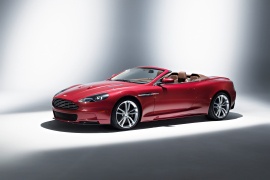ASTON MARTIN DBS Volante Models/Series Timeline, Specifications & Photos
First production year: 2009
Engines: Gasoline
Body style: Convertible (spider/spyder, cabrio/cabriolet, drop/open/soft top)
The British automaker introduced chopped the roof of the DBS coupe introduced in 2007 at the Pebble Beac Concours d'Elegance, and thus, it created its flagship convertible vehicle.
Unfortunately for the brand, in 2008, the world financial crisis started to hit most automakers. One by one, Chrysler, GM, and Ford had to shrink their activities. At that time, Aston Martin was owned by the blue-oval automaker, and its future was not very secure. But still, the carmaker managed to launch the beautiful DBS convertible at the 2009 Geneva Motor Show.
Based on the same VH platform as the DBR9, the Volante version featured a similar front fascia with a wide chromed grille at the front filled with horizontal slats. On the lower side of the bumper, in the apron, the automaker installed a second grille flanked by a pair of scoops that channeled the air around the car lowering the drag resistance. From its profile, the open-top GT sported a vent on the front fenders, behind the wheel arches, while the wave-shaped beltline continued towards the car's end. At the back, two exhausts poked through the rear diffuser with their chromed tips.
Inside, the DBS carried over several design elements from its siblings. While some of the switches and buttons were also received from Ford, other parts, such as the aluminum trims and the steering wheel, were unique. In addition, a set of aluminum pedals and the six-speed gear stick reminded the driver that it wasn't just an ordinary vehicle. Like any Aston Martin from that era, the DBS sported a leather-clad interior and sports seats with integrated headrests embroidered with the model's logo.
Under the hood, the automaker installed a 5.9-liter V8 engine derived from the racing unit installed in the DBR9 and DBRS9 race cars. Power went to the rear wheels via a transaxle, rear-mounted gearbox, and a limited-slip differential.
